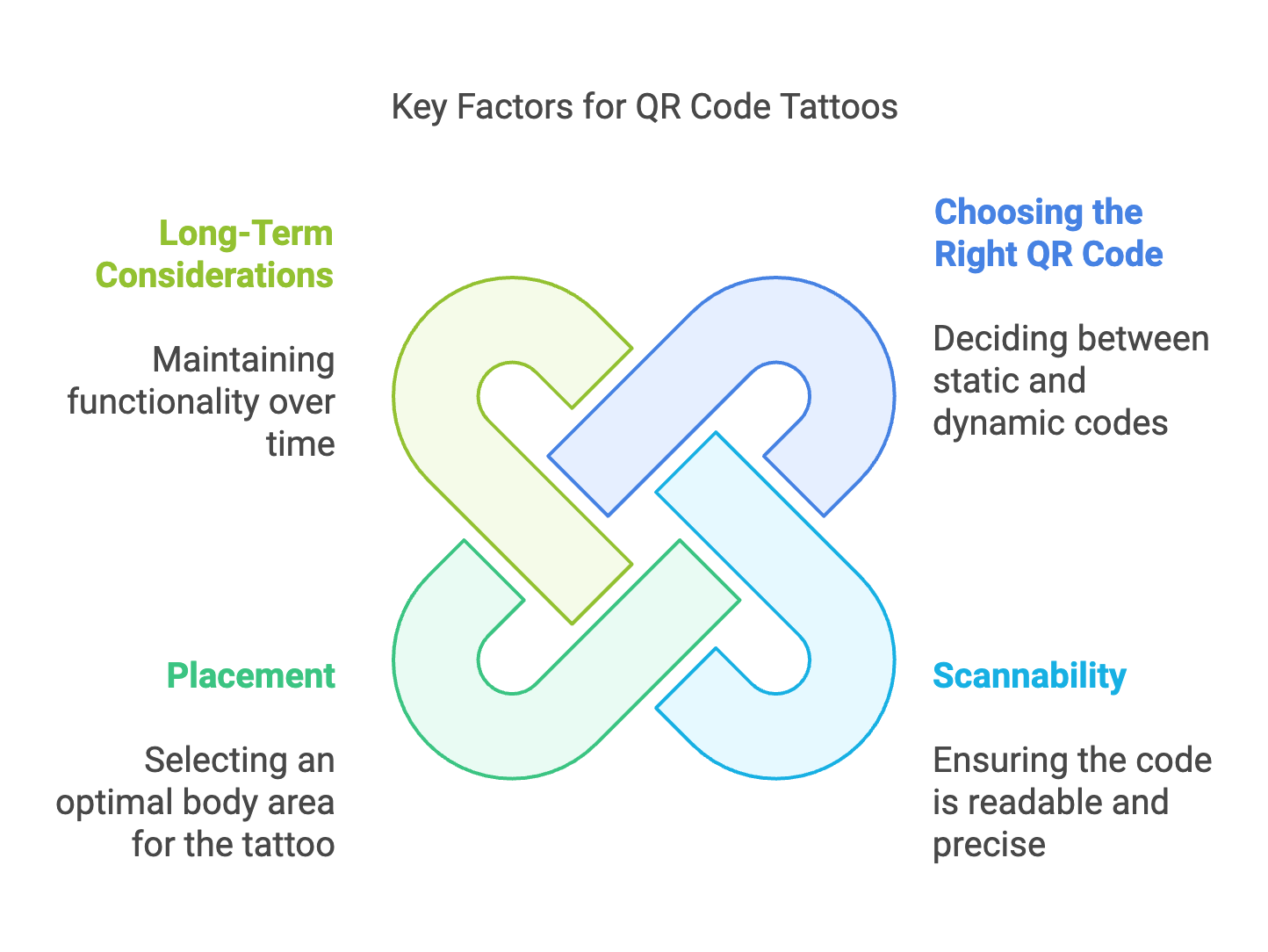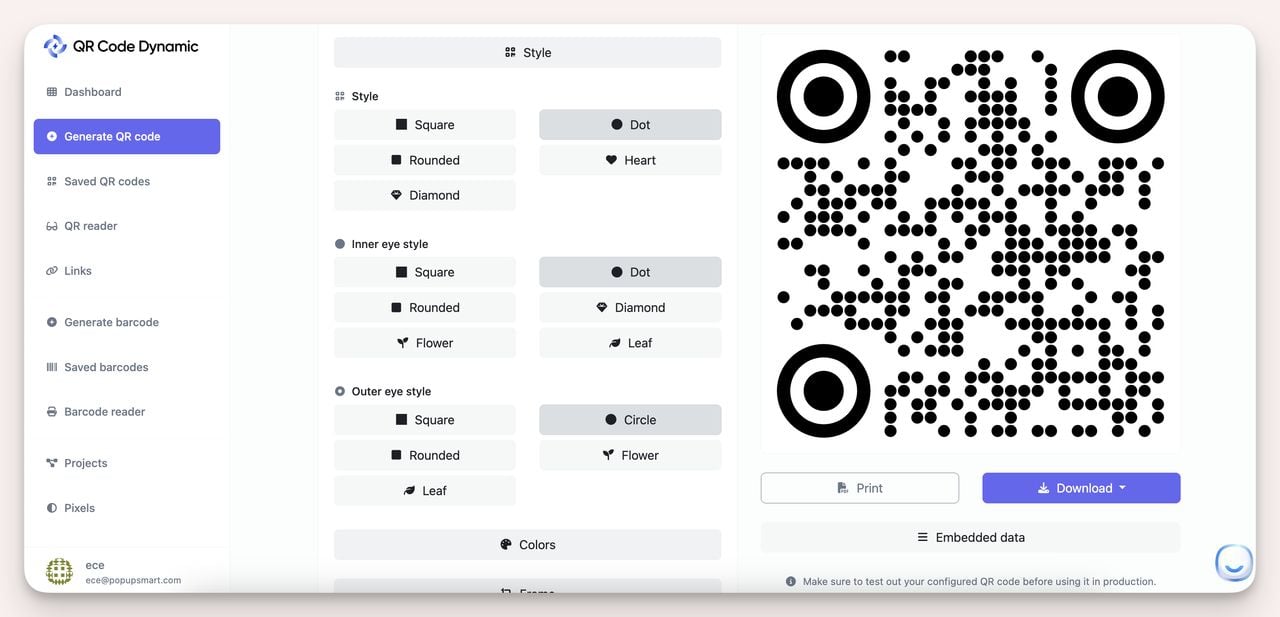Have you ever wondered what it would be like to carry a piece of the digital world on your skin?
That’s exactly what QR code tattoos offer—a gateway to your digital life with just a quick scan. Whether it links to a heartfelt hidden message, your Instagram, or a favorite song, this trend is redefining personal expression.
But how do you ensure it’s scannable? What if the link needs to change? In this guide, I’ll answer your questions and share tips to help you decide if this futuristic tattoo is right for you.
What Are QR Code Tattoos?
A QR code tattoo is a unique type of body art that incorporates a scannable QR (Quick Response) code into the design.
Just like the QR codes you see on product packages or advertisements, these tattoos can be scanned using a smartphone or a QR code reader to access digital content.
The linked content can be anything from a website URL or a social media profile to a video, photo album, or even a hidden message.
The idea behind QR code tattoos is to blend traditional tattoo art with digital interactivity.
They serve both as a personal expression and as a functional tool, connecting the physical body to the digital world in a seamless way.
How Do QR Code Tattoos Work?
QR code tattoos work the same way as printed QR codes. Once the tattoo is scanned, the code directs the scanner to the encoded destination.
However, for the tattoo to work correctly, it must be designed and inked with precision. Any distortion, fading, or stretching of the skin can affect the code's scannability.
Things to Consider Before Getting a QR Code Tattoo

Choosing the Right QR Code
When planning a QR code tattoo, the first step is deciding what type of QR code you need. There are two main types to consider:
- Static QR Codes: These link to permanent content, meaning the destination can’t be changed after the tattoo is created. If you’re linking to something timeless, like a memorial page or a favorite quote, a static QR code may be the right choice.
- Dynamic QR Codes: Dynamic codes allow you to update the linked content as often as needed. For example, you can start with a link to your social media profile and later switch it to a portfolio or a playlist. This flexibility makes dynamic QR codes the preferred choice for most tattoos.
⭐ To understand the difference even better: “What are the Differences Between Static & Dynamic QR.”
Scannability Is Key
Ensuring that your QR code tattoo is scannable is crucial. Here’s what you need to keep in mind:
- Design Precision: The QR code must be designed and tattooed with exact detail. Even minor distortions in the lines or spacing can render it unreadable.
- Size Matters: A QR code tattoo needs to be large enough for scanners to pick up all the details. A minimum size of 2x2 inches is recommended for reliable scannability.
- Test the Code: Always test your QR code design by printing it out and scanning it with different devices before getting it tattooed.
Placement Matters
The placement of your tattoo plays a big role in how well it works. You want to choose an area of the body where:
- The skin remains stable and doesn’t stretch significantly over time (e.g., forearms, calves, or upper back).
- It’s easy to scan without awkward angles, such as flat surfaces on the arms or legs.
- There’s enough space to accommodate the size of the QR code without distorting it.
Avoid areas prone to frequent changes, like the stomach or inner wrist, as these could affect the code’s functionality over time.
Long-Term Considerations
A QR code tattoo may look great when freshly inked, but it’s important to think long-term:
- Fading Over Time: Tattoos naturally fade, and this can impact the QR code’s readability. High-quality ink and regular touch-ups can help preserve its scannability.
- Skin Changes: Aging, weight fluctuations, or stretching can distort the QR code, so choose a placement with minimal movement.
- Future Relevance: If you opt for a static QR code, consider whether the content it links to will remain meaningful or relevant in the future.
By considering these factors, you can ensure your QR code tattoo is both functional and long-lasting.

How to Create a QR Code for Tattoo
Here’s a step-by-step guide to creating a QR code specifically for a tattoo using QR Code Dynamic.
Step 1: Plan the QR Code Content
Define the Purpose: Decide what the QR code will link to, such as a website, video, text, or contact information.
- For tattoos, simpler content like URLs or short text works best to avoid dense codes.
Dynamic vs. Static QR Code:
- Dynamic QR Codes: Can be updated later, even after the tattoo is done.
- Static QR Codes: Permanent and cannot be changed.

Step 2: Create the QR Code Design
1. Generate the QR Code:
- Go to the "Generate QR Code" section on the QR Code Dynamic platform.
- Select the content type (e.g., URL or text) and input your data.

2. Choose Tattoo-Friendly Styles:
- Use simple styles for better readability. Avoid overly intricate designs that may distort when applied to skin.
- Inner and Outer Eye Styles: Opt for clean and bold styles like "Square" or "Circle."
- Avoid overly artistic styles (e.g., "Flower" or "Heart") that might reduce scannability on uneven skin.

3. Color Selection:
- Use high-contrast colors (black foreground on white background is ideal) for tattooing.
- Gradients and colors can fade over time on the skin, making the QR code less scannable.
4. Add a Frame or Branding (Optional):
QR frames with text (e.g., "Scan Me") can make the tattoo more intuitive for others.
- Adding a logo is optional but ensure it doesn’t obstruct the QR code’s readability.
Step 3: Test the QR Code
- Before finalizing the design:
- Download the QR code and test it multiple times with QR code reader to ensure it works.
- Print the QR code at the size you want for the tattoo, and test its scannability.
Step 4: Work with a Tattoo Artist
1. Find an Experienced Artist:
- Choose an artist skilled in precision work like micro tattoos or geometric designs.
- Share the high-resolution QR code file with them.
2. Placement Matters:
- Avoid body parts that may stretch, wrinkle, or experience frequent motion (e.g., elbows, knees, or fingers).
- Recommended areas: Upper arm, forearm, or back.
3. Size of the Tattoo:
- The tattoo should be large enough for scanners to read the QR code accurately.
- Generally, a QR code tattoo should be at least 2x2 inches (5x5 cm).
4. Ink Density:
- Black ink is the most reliable for QR codes. Colored or shaded tattoos may impact scanning accuracy.
Step 5: Tattoo Testing
1. Temporary Tattoo: Create a temporary version of the QR code (using printed transfer paper or stencils) to test its functionality on your skin before committing to a permanent tattoo.
2. Verify Post-Tattoo: After the tattoo is completed, test its scannability immediately while the skin is clean and undistorted.
Step 6: Aftercare for a Functional Tattoo
1. Follow Healing Protocols:
- Follow your artist’s instructions for aftercare to avoid infections or scarring that could distort the QR code.
2. Maintain Clarity:
- Avoid excessive sun exposure or weight fluctuations that might stretch the tattoo.
Creative Ideas for QR Code Tattoos
If you’re considering a QR code tattoo, here are some creative ideas to inspire your design:

- Memories and Sentiments
Link your tattoo to a digital photo album, a heartfelt video, or a written letter from a loved one. This allows you to carry sentimental moments in a unique way. - Music and Playlists
Add a link to your favorite song, playlist, or even your own music if you’re a creator. Platforms like Spotify or Apple Music can provide quick access to meaningful tunes. - Social Media Profiles
If you’re an influencer or content creator, direct your tattoo to your Instagram, TikTok, or YouTube channel. It’s a functional way to connect with people in real life. - Hidden Messages
Create a QR code tattoo with a hidden message, like a personal motto, a joke, or a surprise note that’s revealed when scanned. - Artistic Designs
Blend the QR code into a larger tattoo design. For example, incorporate it into a mandala, a geometric pattern, or even a meaningful symbol for added creativity.
QR Code Tattoos in Pop Culture
QR code tattoos have made waves in pop culture, with celebrities like Katy Perry embracing this tech-inspired trend. At the 2024 MTV Video Music Awards, Katy Perry turned heads not just with her performance but with her striking lower-back QR code tattoo.
Though temporary, her tattoo showcased the growing appeal of this trend in mainstream culture. Her QR code linked to the pre-save page for her upcoming album, blending personal branding with body art in a way that’s impossible to ignore.
(Source: Getty | Dimitrios Kambouris)
Moments like these highlight how QR code tattoos are becoming a statement piece, not just for everyday individuals but also for celebrities looking to make a memorable impact.
FAQs About QR Code Tattoos
How Long Do QR Code Tattoos Last?
QR code tattoos can last a lifetime, but their functionality depends on proper care and maintenance. Fading, skin changes, or poor design precision can affect scannability over time. Regular touch-ups can help preserve the design.
Can QR Code Tattoos Be Updated?
If you choose a dynamic QR code, the linked content can be updated as needed without altering the tattoo itself. This makes dynamic QR codes a flexible option for evolving needs.
What Are the Limitations of QR Code Tattoos?
- QR codes must be large enough and precise to remain scannable.
- They can fade over time, affecting functionality.
- A QR code tattoo requires a device with a camera and internet access to decode the message.
Final Thoughts
QR code tattoos offer a unique way to blend art and technology, allowing you to link your ink to the digital world.
Whether you want to memorialize a loved one, share a personal message, or showcase your brand, these tattoos provide endless possibilities for personalization. By following best practices and working with a skilled tattoo artist, you can ensure your QR code tattoo is both functional and meaningful.
If you’re ready to explore this innovative trend, take your time to design and test your tattoo carefully—it’s not just body art; it’s a gateway to something more.
For further reading, you might be interested in the following:


